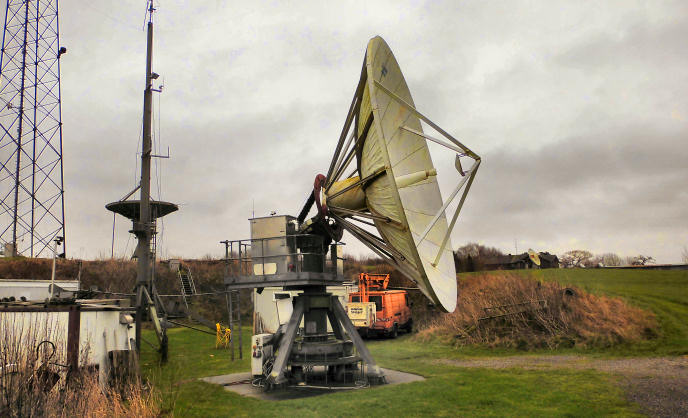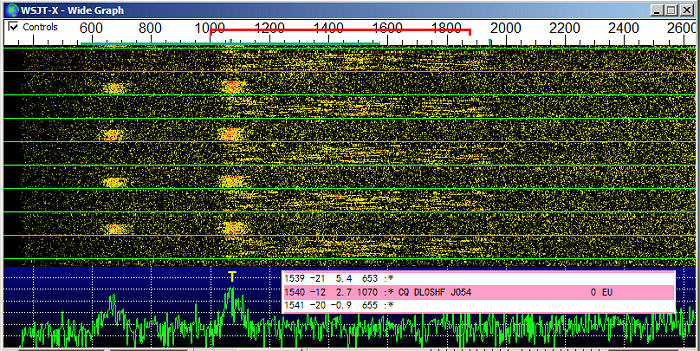The DL0SHF 10GHz EME Beacon
The DL0SHF beacon is a tremendous resource for anyone interested in 10GHz EME. It not only gives you something to listen when activity is low (which is much of the time!), but provides a frequency reference (10368.025 MHz)and a constant strength signal which can be used for testing system performance.DL0SHF is located in Kiel-Ronne, Germany (JO54CG), and is part of a complex of antennas associated with The University of Kiel and includes antennas used for education and radio astronomy, as well as Amateur microwave tropo and EME - See https://sat-sh.lernnetz.de/.

The dish used for the 10 Ghz DL0SHF beacon.
- Dish diameter - 7.2m (23.5ft)
- Feed system - Cassegrain
- 3dB beamwidth - around 0.3 degrees
- Antenna gain - 54.7dBi
- Power - around 40W from a solid state amplifier is "normal". Can be lower of higher power at times
- Tx Frequency - 10368.025000 - GPS referenced
- Polarization - Vertical (the standard in Europe)
- FSK CW and (usually) Q65-60E
- Locator JO54CG
The modulation scheme is somewhat unusual in that it uses direct frequency synthesis of tones/frequencies rather than using AF modulation of a constant frequency carrier. This is describes more detail by Andy Talbot G4JNT EME Beacon 144MHz Driver Source. The consequence of this is although the beacon's designated carrier frequency is 10368.025000 MHz, you need to tune 1kHz lower, 10368.024000, in order to put the base (lowest) tone of the Q65-60E signal (and the upper tone of the FSK CW signal) at 1000Hz. Note that Andy's paper refers to the original FT4 coding. This was later changed to QRA64 and has now (2021) been replaced by Q65-60E, but the Q65-60E tones are generated in the same way.
The beacon is on the air when both the following criteria are met:
- The elevation of the moon at the transmitter site is > +10 degrees
- The declination of the moon is > -15 degrees (resulting in the elevation of the moon at transit being > +20 degrees). This means it's off for 8-9 days each month when the moon elevation is at its lowest elevation.
Currently (6/20) the beacon seems to be on down to about 3 degrees elevation in Kiel, though signal strength does drop significantly as the elevation approached 3 degrees. There is an online beacon status page which should show the current beacon status, if the monitoring system is working right.
From the start of the Even minute:
- At 1s after the even minute starts, Q65-60E transmission starts. The message is "CQ DL0SHF JO54"
- At about 51 seconds q65-60E transmission stops
- from 51-60 seconds there is no transmission
- (add echo delay time to see when signals arrive!)
From the start of the Odd Minute:
- At 0 seconds FSK CW starts with the tones spaced 400Hz apart. The higher tone is the one to listen to. That corresponds to "Key Down".
- At 25 seconds, CW stops and there are 5 seconds of 10368.025 MHz carrier.
- From 30-60 seconds there is no transmission
NOTE: If temporary changes are made to power and/or mode, a real time notice will be posted in the 10xxx MHz section of the HB9Q reflector when the changes start and stop.
What do you need to see/hear/decode DL0SHF?
The DL0SHF signal is quite strong by EME standards and can be detected using very small dish. With a good Rx system (system noise figure around 1dB) you should probably be able to see and decode DL0SHF with a dish as small as 50cm. With an 85cm dish (which should have 4.6dB more gain than a 50cm dish) and a modified LNBF system with a noise figure probably in the 1.2dB range (see Low lost 10GHz EME Rx), the beacon QRA64D (which was being used at the time of this reception) transmission decodes at around -12dB when the moon is near perigee. The CW signal is audible and very visible on the waterfall display of WSJT-X, but I have not yet managed to read it! To hear/see/decode the beacon there are three things you have to get right:
- Tune to 10368.024 MHz and...
- Set the correct Dopplet compensation (this can change by 60Hz/min or more, so Doppler tracking is needed if you want the best chance of decode anything).
- Polarization. DL0SHF transmits on Vertical Polarization. The Rx station needs to compensate for spatial polarization offset (Dpol in the WSJT-X Astronomical window). If you up to 30 degrees off, you'll see less than a 1dB drop in signal, but at 45 degrees you will lose ~2dB and if you are 90 degrees off you probably won't see anything at all (~10 to 15dB of added loss).
If you get everything right you should see something like this on the WSJT-X waterfall:

PA0EHG reports reception using a 48cm dish, a DB6NT pre-amp with 0.7 dB NF and a DB6NT transverter
The primary contact for the DL0SHF 10Ghz beacon is Per Dudek, DK7LJ. We all appreciate his work, and the work of all the other team members who keep DL0SHF on the air.
.jpg)